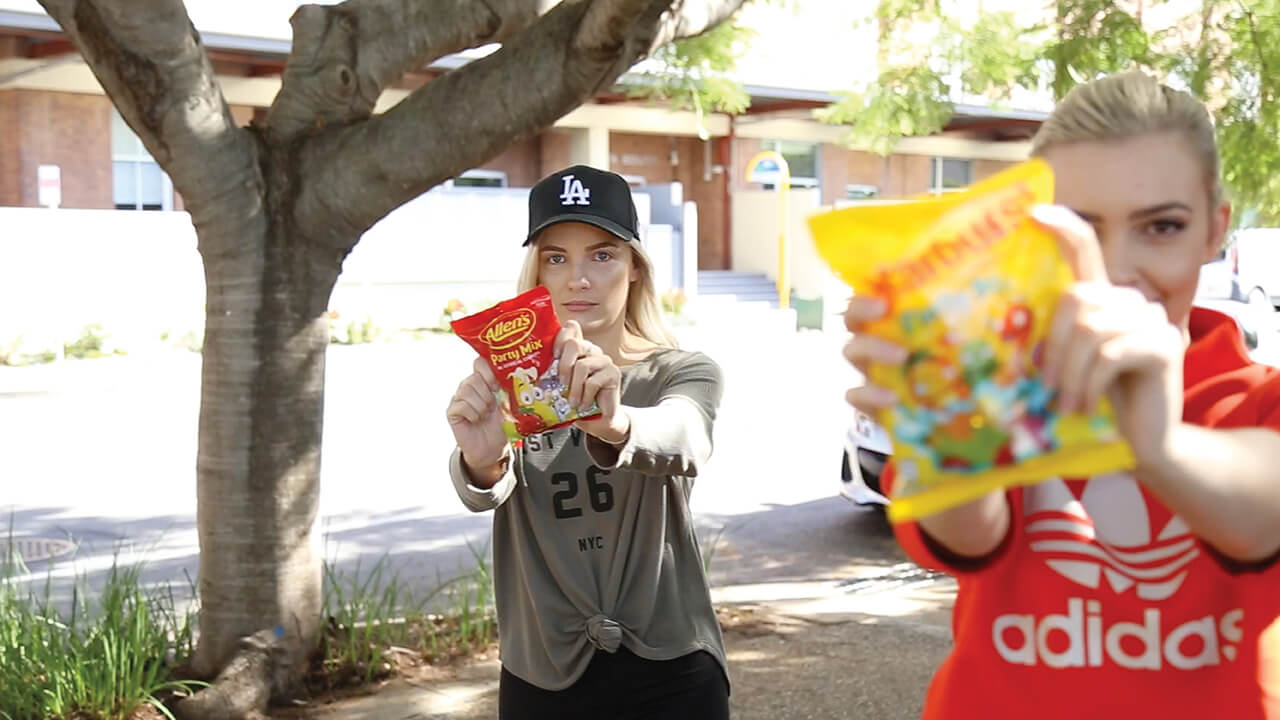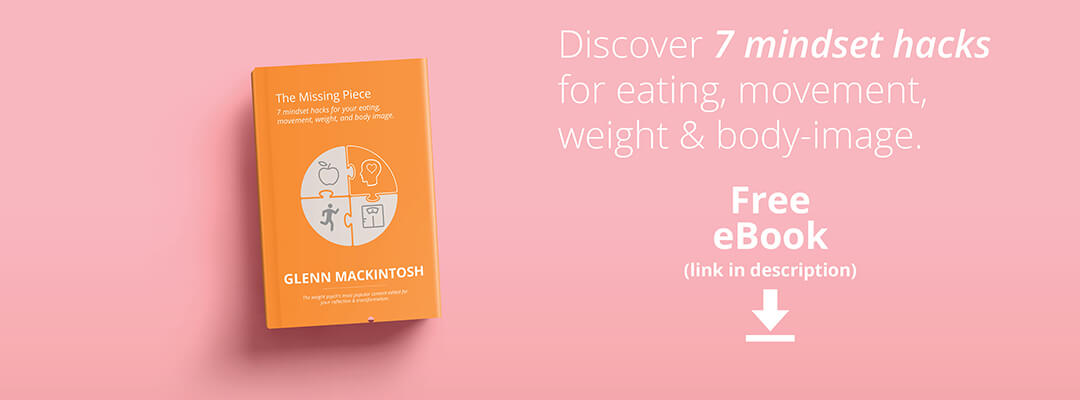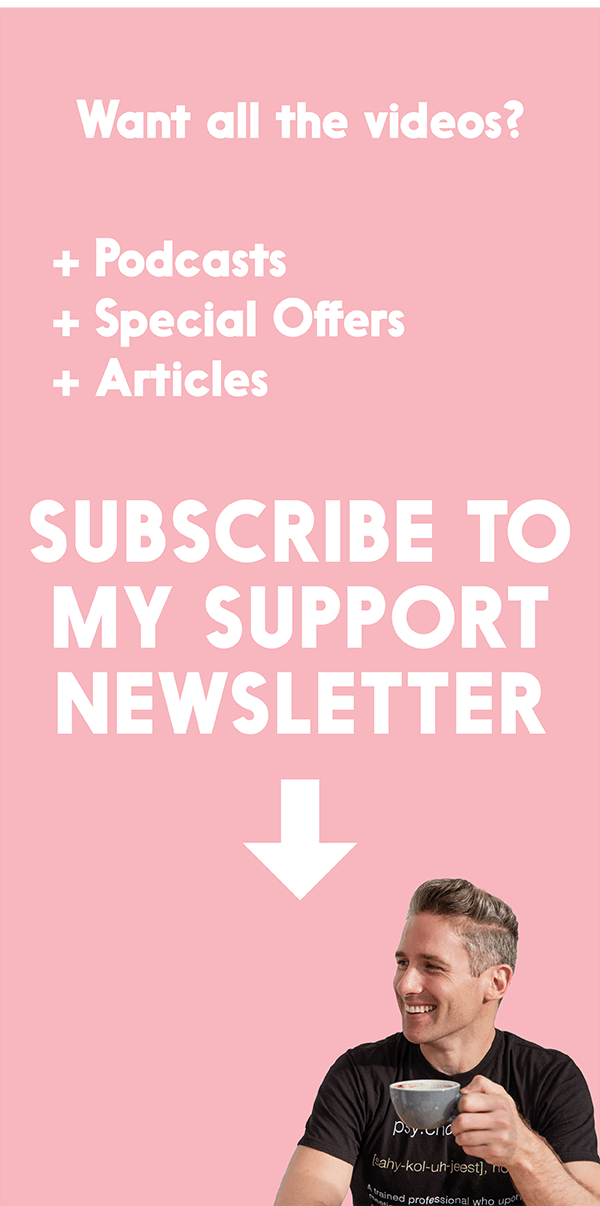
In this Thursday Therapy episode, Glenn helps you understand how you can manage food rich environments, and turn saboteurs into supporters, making healthy eating easier and more sustainable.
Watch Video
I created this video for people just like you.
If you found it valuable, please help me share it with them!
SHOW NOTES
- Question from dietitian Gemma on what to do when your environment is sabotaging you. [1:09]
- The “Obesogenic Environment”. [2:38]
- Auditing the “Availability, Visibility and Proximity” of high calorie, low nutrition food. [3:32]
- Glenn’s example of setting up your family environment to suit you. [5:32]
- Using Availability, Visibility & Proximity with more nutritious foods. [6:19]
- Turning saboteurs into supporters. [8:01]
- Talking with people about why you’re doing what you’re doing. [8:33]
- Teaching people how to help you. [10:24]
- Parting thoughts and key ideas to try. [11:04]
- Blooper reel – real example of availability, visibility & proximity! [13:10]
TRANSCRIPT
Hey everyone, welcome to Thursday Therapy. I’m Glenn Mackintosh, the weight psych, and the question we’re answering today is about when there’s too much food around and lots of people offering it. Welcome to Thursday Therapy where I answer your questions on the psychology of eating, movement, weight and body image. Let’s get into today’s question which comes from Gemma. “Hi Glenn, I’m Gemma. I’m a sports dietician at dietician without borders. I love Thursday Therapy, getting in the right mind-set is so important for being able to make changes that are sustainable and I love what you’re doing, so I’d love to hear your thoughts on what to do when you’re in an environment that is sabotaging you from achieving your goals. I work with some really motivated people and athletes and stuff and a lot of the time they’re in these environments. So, particularly at work where there are people around them that are feeders and they’re bringing biscuits and cakes and stuff and they don’t mean to but they’re walking past it and they pick something up and they eat, sometimes a few times a day and so this is undermining them from being able to achieve their goals whatever it is, so I’d love to you what you can recommend that I can be suggesting to them that help them stick with their resolve a bit more.” It’s a great question Gemma and I love your outside video, that’s really cool and I also love that you’re sharing TT (Thursday Therapy) with your clients. I think that dietitians and psych’s, we’ve got to be best mates in this space, so it’s really cool to hear that Thursday Therapy is getting out through you guys. As you know we follow a non-dieting approach and Gemma I know you’re familiar with this, so no foods are banned but I think it’s really important that we talk about this because if you’re constantly overeating foods just because they’re there or just because someone’s offering and that’s not intuitive eating and that’s not going to be great for your overall health. I think it’s really important that we talk about our environment, researchers talk about an obesogenic environment, we’re in a really weird time in human history and it’s the first time where we haven’t hunted food but food hunts us. Typically, the food that’s hunting us through consumer product advertising is very high calorie and quite low in nutrition. People often blame themselves for their weight gain but the obesogenic environment is a single biggest contributor to the weight gain of the world, so while we can’t control those macro environments that we’re in, we can manage these micro environments that we’re in day to day and I want you to think about three things in particular; the first thing that I want you to think about is just the availability of that high-calorie, low nutritional. So, if it’s not in your house, if it’s not in your car, if it’s not in your work place then it’s going to be a lot easier to manage. Now, of course this isn’t always possible but sometimes you might be surprised with how possible it is. I’m a food psychologist as you would expect I do this really, really well but I know right now there is ice cream in the freezer from doing tapping with a client and just because it’s there I have to have a little mental battle in my head to not eat it if I don’t want to whereas if it’s not there, no mental battle. So, part of this is not about making foods bad or wrong but just creating the environment where you can make great choices with low willpower. The second thing that I want you to think about is the visibility of the food. So, now that I’ve bought it from the fridge to the bench it’s much more visible and it’s much more tempting, so it really is a case of a lot of the time out of sight out of the mind and you can use that mental trick to help you make better food choices. The third thing that I want you to think about is proximity, so now that the ice cream is moved from over here to right in front of me it presents a bigger cue and it takes more mental energy for me to say no to it, so what I want you to do is I want you to think about how you can transform your little environment in a way that’s right to you. I’m not saying you have to necessarily get rid of all that food out of the house or you know tell the kids that they can’t eat any of these foods ever again, you’ve got to find a way of this working that’s right for you but I’m sure that with a little practice and a little creativity you could definitely do it. For example, a little thing that I like to do is we have this lovely family routine where we will just get lollies while we’re watching TV and we’ll just pass them and circulate the morale each other just continually eat them, so what I say to my family is, look guys, don’t pass it to me, I know where it is and I sit in front of it so I’m watching the TV so I can’t see it. It’s not close to me and then if I ever thought, oh, I want a lolly or I want an ice cream or something, I just go up to where it is, probably near the couch and I go and grab it and I come back down. So, that’s an example of how that works and how you can make it work in a way that is right for you. Another idea that can be really helpful for you and I really like this one because I prefer to be positive where possible, is to use the power of the environment to encourage you to eat more nutritiously and drink more nutritiously. So, you can use that availability, visibility and proximity for the power of good rather than evil. You can see I’ve been you know drinking this water as we’ve been filming just because it’s here, so doing something like putting the water glass there at work so you can drink more water can be really good, another thing is that that a lot of people that I’ve seen have done is have some fruit that goes along with the cakes and the biscuits and the chocolates at morning tea and often, it’s funny, a lot of people actually really want to have the fruit or the yogurt or the nuts or the more nutritious food when it’s offered because often that stuff goes first, so it’s not necessarily that everyone always wants the cakes and everything, not there’s anything wrong with that, but you might decide and you might be able to kind of push for some more nutritious food to go with the less nutritious food at those type of work events. Another thing that you might do that a lot of my clients have success with is, you know, at those events, if you don’t really necessarily want to eat those tempting foods, for you at that time just have like a cup of tea in one hand with the saucer in the other hand that way you’ve got that very available, very visible, very proximal cue, they’re kind of acting like a barrier that food that you don’t want to eat at that time as you’re probably thinking and this is part of your question, Gemma, something that can make this all a bit more challenging is people, you know, we are all products of this environment and therefore we don’t necessarily all eat or drink that healthily and we probably eat and drink less nutritiously when we get together. So, let me give you a few thoughts on having some discussions with people and helping them get on board with supporting you. The first thing that I want you to think about is telling people what you’re doing but actually telling people a little bit about why you’re doing it. You know, a lot of us go on health kicks these days and it’s almost like this unstated expectation that people will be on a health kick and they’ll be off a health kick and sometimes if you are not that confident that you’re going to succeed with your health kick, you kind of keep it to yourself but I did my research in psychological and social factors and weight management and the better your support from other people, the better you’ll tend to do. So, I’m a big fan of, in a way that’s right for you and in a way that’s right for the people around you, having those discussions about what you’re doing and having them about why you’re doing it as well, so for example, oh no, I don’t want to eat that because I’m going on a health kick, it’s probably not as powerful, someone’s not going to get that as much as, you know what, every year my family does this fun run and I’m always the supporter and I love supporting them but the truth is I hate not being able to do it, that really sucks for me, so this year I’ve signed up. So, can you support me by not offering me that stuff because I’ve really got a goal and I really, really want to get there. I think that people actually love and I see this all the time with my clients and they have these conversations, people love to be a part of something positive, they love to see you doing that fun run and go, yeah, I kind of helped that, or whatever it is that’s important to you and that’s true whether you are an athlete, whether you’re an amateur athlete or whether you just want to be a fitter healthier person. So, I think tell people what you’re doing, tell people a little bit about why you’re doing it and then also tell them exactly how they can help you because people don’t necessarily know how they can help. For example, a lot of people that I see you know they don’t necessarily want a food policeman saying, oh, should you be eating that? they might just like someone to say, you know what, when I’m eating this food, when you’re all eating this other different food, let’s just not make it a big deal, so think about exactly how that person could best help and give them the credit, that if you tell them, really the deep reason why you’re doing it, that people love to be part of something positive and they’ll jump on board. So, guys we’ve talked about some different stuff today but I really want you to consider your environment and consider whether having more availability, more visibility, more proximity of the more nutritious foods and on the other hand less availability, less visibility and less proximity of the less nutritious foods could really help you eat healthier without investing so much effort and willpower into it so as Gemma said it is more sustainable over time. Guys, I don’t know your exact situation and there might be definitely some things from today that won’t necessarily work for you but I would really encourage you to get creative and to experiment with some of these things because often you will be surprised and changing around that physical environment can be totally transformational, it’s not the whole puzzle but it can be a very important piece of the puzzle in your long-term success. The same with your conversations with people. I don’t know everyone around you and there’s no guarantees that these ideas will work with every person but I think if you take the principles I think you’ll really find that they really, really benefit you. So, thanks again to Gemma, from dieticians Without Borders, for your question. Gemma is a dietician, a sports nutritionist, a cyclist a triathlete and who I really appreciate is very interested in the non-dieting space, so if you’re a bit of a fitter healthier sporty-er person or you could see yourself being one of those people in the future make sure you follow Gemma. Gemma again thanks to your question and thank you all for being part of another Thursday Therapy and I’ll see you in a couple of weeks.





